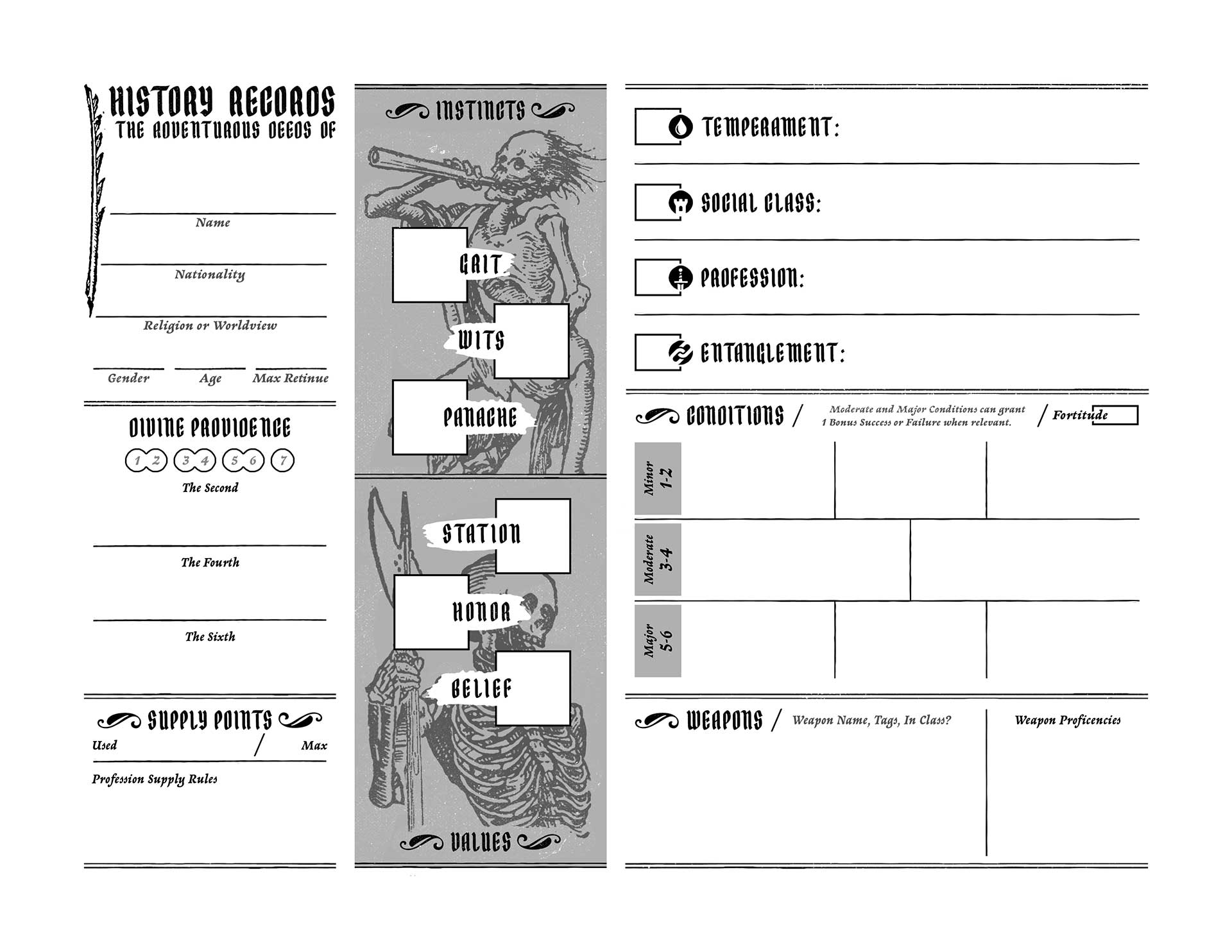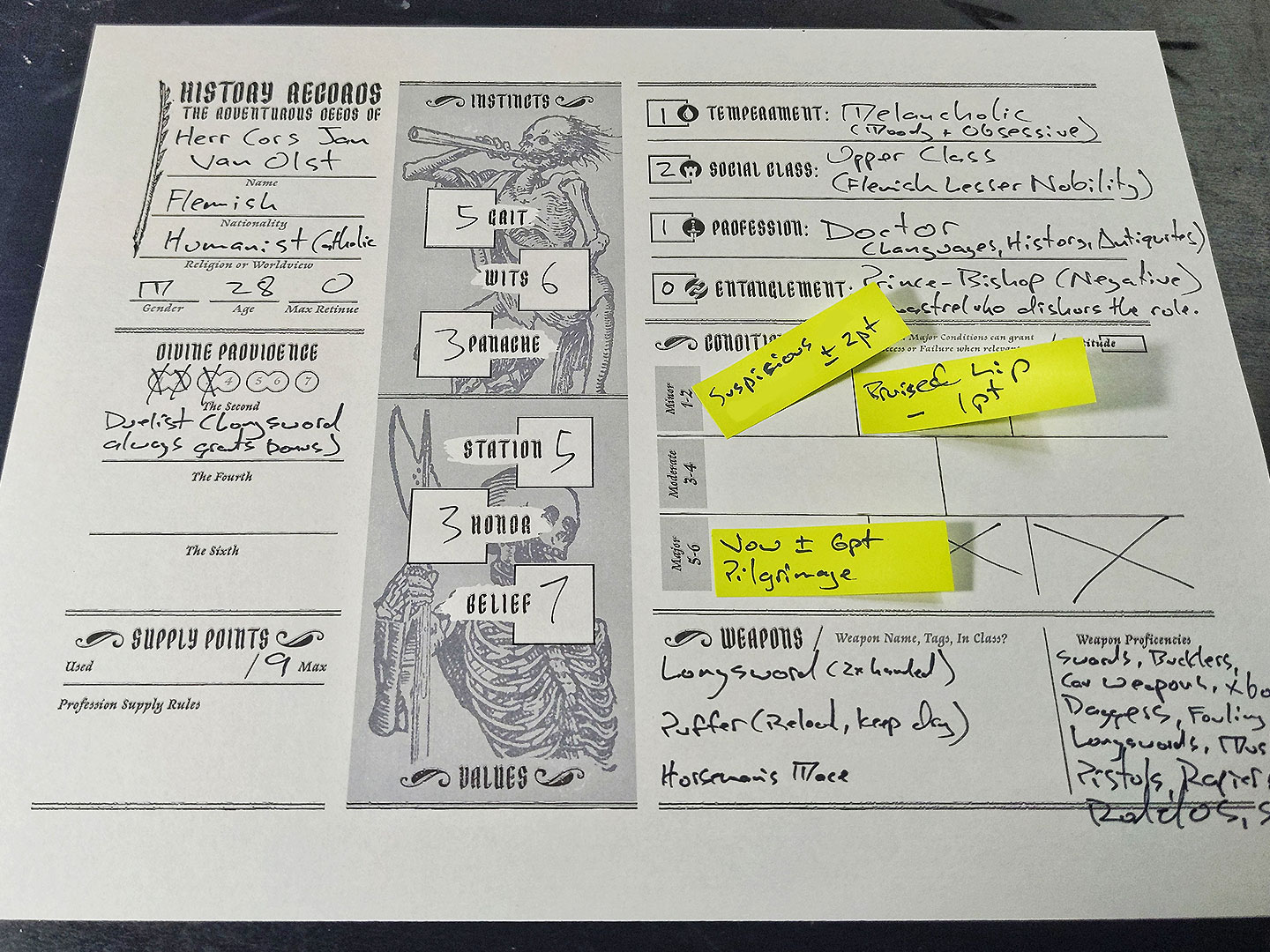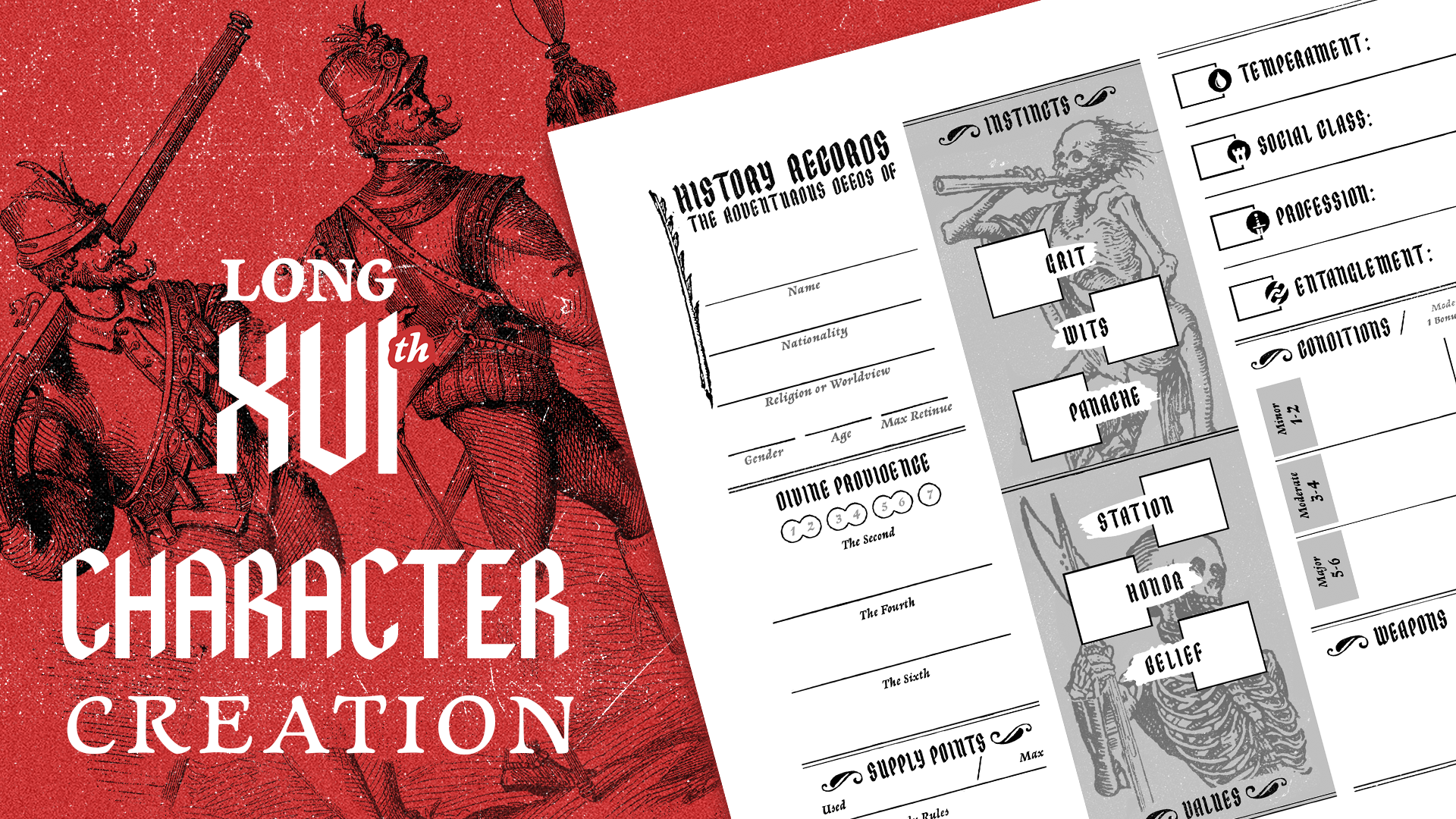Note: this content is out of date. Design and playtesting of LongXVIth has gone on. The rules and documents linked in this post may not represent the most recent version of the game.
Just here for the downloads? You got it.
- Character Sheet: LongXVIth_CharacterSheet_v03.1.pdf
- Player’s Guide Excerpt: LongXVIth_Excerpt_PlayersGuide_v01.pdf
Long XVIth is a roleplaying game I’m writing and playtesting for adventures in and inspired by Renaissance Europe. I’m a history nerd fascinated by this era; this is my justification to play within it.
Its mechanics take the spirit of the OSR (random character generation, streamlined mechanics, limited mechanical options, potential lethality) and drape it across an abstract, narrative framework that can be seen as a distant relative of Fate and City of Mist.
While this is an explicitly historical game, but it would also fit low-magic games of Warhammer Fantasy (the Old World, not the hyper fantastic Age of Sigmar) or a politically-focused version of The Witcher (more schemes and plots, less monster hunting for hire).
My goal is pay homage to the history, portray it with care and reasonable accuracy… without forcing players to do homework or to suffer overly much when our twenty-first century assumptions and mores but up against what we know of the Renaissance era.
You may see that in the name I’ve chosen, Long XVIth, an explicit homage to a term historians often use: the “long sixteenth century.”
With that introduction, here’s how you make a player character for Long XVIth.
Long XVIth Character Sheets

And here’s what that sheet looks like in play. What it all means follows below.

Elements of a Long XVIth Player Character
If you’re looking for a point of reference on rules complexity, I would compare Long XVIth against Fate Accelerated or a less-complex Blades in the Dark. Here’s what you see in the character sheets above:
- Four Attributes (Temperament, Social Class, Profession, and Entanglement): As a group, Attributes succinctly frame the character concept. The first three are straight forward to understand. The Entanglement is a mechanical tie to the campaign and/or setting’s major factions (think 13th Age’s Icons). These numbers, 0-3, are randomly rolled and can be applied for bonus successes or failures, as appropriate.
- Three Instincts (Grit, Wits, and Panache): These are your core character stats, working similar to Fate Accelerated’s Approaches – but not quite as wide open. Panache also doubles explicitly as a loose coinage and wealth score.
- Three Values (Station, Honor, and Belief): Here we have an alignment system with teeth, although one that bears the most resemblance to – and inspiration from – the Traits system from Pendragon, albeit in a much, much more simplified way.
- Conditions: Taking inspiration from City of Mists’ Status Spectrums, Conditions are Long XVIth’s analogue to hit points. They can be positive, negative, or both, depending on the narrative. Much of the core gameplay loop is built around adding to or decreasing various Conditions. (Conditions also can move up and down in tier, and it was discovered in playtesting that small sticky notes work great for that!)
- Weapons and Weapon Proficiencies: Tactical combat is not a focus of these rules, so weapon rules are largely narrative. However, access to and familiarity with those weapons is not a matter of Profession (the DnD class analogue), but of Social Class. Even so, you’d better fear more the Peasant Soldier with a club than a Noble Chaplain with an ornate rapier.
- Retinue (details not shown): Player Characters may qualify for a small number of Retinue, using simplified character creation rules. Only their max number is listed on the character sheet.
- Supply Points: Instead of usage dice or other ways to simplify equipment and supply, Long XVIth applies the Gear Bubble concept from The Vanilla Game and applies it to all special uses of items and adventuring gear. Also, Professions each have special uses for their Supply Points, which act as the primary mechanical difference for each.
- Divine Providence: Unlike the trend in other OSR-inspired games, Long XVIth is not an inherently lethal game. Using up your Conditions gets a PC “taken out” in ways similar to Fate games – whatever is appropriate to the story and scene. But they can risk death when the stakes are great and important to the character or the party. Here they call on Divine Providence to miraculous salvation. This unlocks character advancements, but there is a limit to how many times they can risk it – and that number is unknown to the players. It is randomly rolled by the GM at character creation. This is a mechanic that was taken from the “Praise Jesus” rule from the Nineties-era satirically x-treme RPG H.O.L. (and cleaned up and given a much different narrative spin).
And there you have it: a full Long XVIth player character.
How’d I Get Here? A Short Project History.
My earliest concepts for a historic, no-magic RPG for “adventures in and inspired by Renaissance Europe” began during the pandemic summer of 2020. At that time, it was a reskinning and adaption of OSR rules (similar in spirit to what Kevin Crawford has done with Wolves of God for post-Roman Britain).
Inspired greatly by what I was encountering in the OSR scene, my lightweight hack began to do three things as I explored and tinkered with its rules:
- Mutate away from much of the OSR / d20 chassis (six attributes, xp & levels, d20 attack rolls, etc.)
- Bloat up in my attempt to “capture the essence” of the period with rules for weapons and armor, alchemical and astrological pseudo-science in place of spells – with lists of spells to accompany, and so on. The rules were veering dangerously close to no longer being rules-light.
- Crumble under the weight of that same, pedantic (and wildly insecure) desire to do right by the history. As some of my readers may know, I’m a big history nerd – which is what’s lead me to this project in the first place. My worries were backing me into stasis.
At the same time, I had been running my gonzo stupid fun time rules, Apocalympus, with friends online on a quasi-regular basis. I found the rules worked and were easy for players to grasp. The risk vs. reward 1d-3d10 dice pool that counted successes and failures lead to a lot of fun moments.
So as feedback from Playtest 04 of my miniatures skirmish game 15XX stalled, I pivoted back into my historical RPG project and began using the lightweight Apocalympus chassis as a fresh starting point.
Long XVIth has grown and changed significantly from Apocalympus, where now all that is clearly identifiable is the risk vs. reward dice pool and roll-under mechanic. (And I’m even thinking of changing that for Apocalympus to streamline it further!)


[…] into how the current iteration of the game works and looks, along with the (somewhat deprecated) Long XVIth character creation rules from a few weeks […]